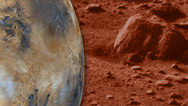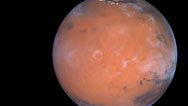Martian Weather
- Posted 12.30.08
- NOVA
With huge temperature swings and not a drop of rain, what could Mars weather have in common with the weather on Earth? In this video short, planetary scientist Vicky Hipkin reveals similarities—and, of course, a few rather significant differences—in our planetary weather reports. Hipkin also discusses discoveries from NASA's Phoenix lander, which spotted dust devils, frost, and even snow from its outpost near the north pole of the Red Planet.
Transcript
Martian Weather
Posted: December 30, 2008
VICKY HIPKIN: So both planets have major similarities. The sun is the source of energy in both cases. The sun is driving the circulation of the air, and it's driving it in the same kinds of ways. We have a hot equator in both cases and the colder polar region. Both planets also have icy polar caps. And they both rotate with a period of around 24 hours. The day on Mars is 24 hours and around 40 minutes. And the other thing that's very similar, and quite bizarrely similar, is that both planets are tilted with respect to their orbit around the sun, and that's what gives both of those planets seasons. So both planets have those major similarities, and that's kind of where the similarities stop I guess.
The big differences are Mars is a little further away from the sun, so we'd expect temperatures to be cooler. At the equator temperatures in the morning might be -50 [Celsius], say, and then at 2 PM you'd be up to 0 or +10 [Celsius]. So that huge change is very different from Earth. So while the Earth atmosphere is around 80 percent nitrogen, 16% oxygen, the Mars atmosphere is 95 percent carbon dioxide. With its atmosphere of carbon dioxide and its low temperatures, each winter about 30 percent of the whole atmosphere freezes out onto the polar caps. So on top of the water ice, there's a layer of carbon dioxide ice as well.
The amount of water is very tiny. If all the water in the skies above froze down onto the surface, we're looking at a layer of water on the surface of Mars that's thinner than a human hair. It's a tiny, tiny amount of water. Mars is a dry, icy planet and its atmosphere is much thinner than the Earth's. It's about 1 percent of the pressure of the Earth's atmosphere. And what this actually means is the pressure is so low that water isn't actually stable in its liquid form, so if you have a glass of water on Mars it would instantly evaporate, and that's just a function of the surface pressure there.
The Phoenix mission produced weather reports for the first 90 days that were fairly constant. It really would have been a fun time to be there—nothing like clear sunny weather. And then at the end of that time that's when we started to see quite interesting cloud formations. Se could see that they were moving by at altitude at some speed, and you could see them forming and evaporating as well. And we started to see these dust devils. A dust devil is a mini tornado, a little whirlwind that is lifting dust off the surface. And we did start to see frost. And we saw this quite beautifully as well. For the very first time we saw evidence that crystals of water ice were actually falling out of the clouds, and that was our basis of our discovery of snow on Mars.
In the future, as long as we all had space suits on, I think there would be a lot of fun things to do. There's lots to explore. I'm sure it's very pretty as well. So for people who like exploring the unknown, it would be a fabulous place to go to.
Credits
Images and video
- (Mars, Earth, sun)
- Courtesy NASA/JPL
- (Vicky Hipkin)
- Courtesy Canadian Space Agency
- (clock)
- © istockphoto.com/russelltate.com
- (sun and snowflake)
- © istockphoto.com/enjoynz
- (street sign)
- © istockphoto.com/SilkenOne
- (thermometer)
- © istockphoto.com/omergenc
- (water drop)
- © istockphoto.com/lushik
- (vice)
- © istockphoto.com/jangeltun
- (glass of water)
- © istockphoto.com/AlonzoDesign
- (Phoenix Mars Lander video artist's depiction)
- Courtesy NASA/JPL
- (cloud video, dust devil video)
- Courtesy NASA/JPL-Caltech/University of Arizona/Texas A&M University
- (frost video)
- Courtesy NASA/JPL-Caltech/University of Arizona/Texas A&M University/University of Aarhus/University of Copenhagen
- (photo corners)
- © istockphoto.com/kcastagnola
- (martian surface)
- Courtesy NASA/JPL-Caltech/University of Arizona/Texas A&M
- (martian sunset)
- Courtesy NASA/JPL/Texas A&M/Cornell
- (Victoria crater, dunes at Endurance crater)
- Courtesy NASA/JPL/Cornell
Related Links
-

Phoenix Mars Lander
NASA's latest robot has already found frozen water and is looking for more signs that the Red Planet could support life.
-

Is There Life on Mars?
The decades-long search for life on the Red Planet heats up with the discovery of frozen water.
-

A One-Way Trip to Mars?
Initial shock aside, some space scientists argue this is the only way to go.
-

Does Mars Have Life?
NASA's Christopher McKay thinks the Red Planet once had living things and maybe, just maybe, still does.

